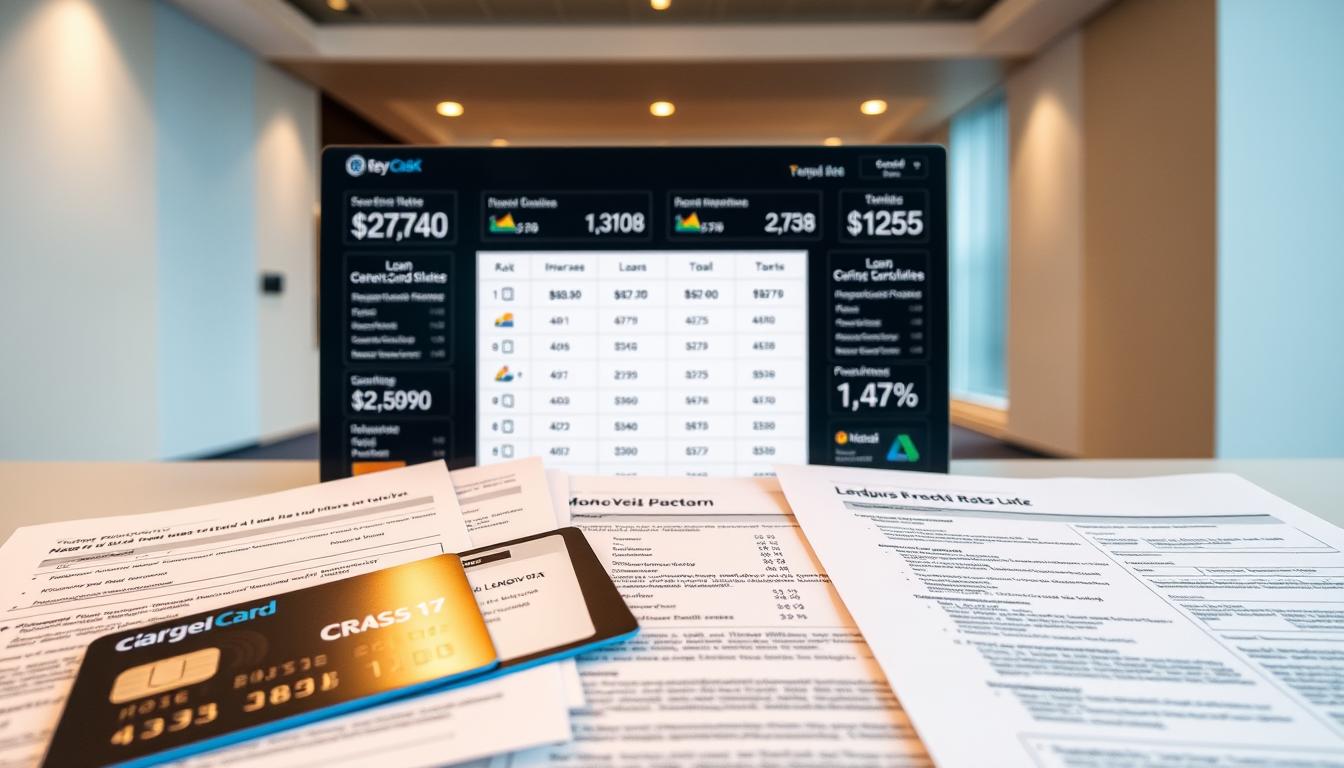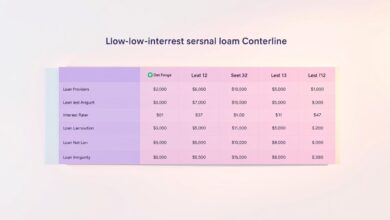College Loans: Compare Rates, Terms, and Offers
Choosing the right financing for your education is a big decision. This guide simplifies the process of comparing options so you can find terms that fit your goals. We’ll break down interest rates, repayment plans, and lender perks to help you save money over time.
Not all education financing works the same. Federal programs often have fixed rates and flexible payment options, while private lenders might offer lower initial costs. Knowing the difference can help you avoid surprises later.
Your credit history and whether you have a cosigner matter, too. Even small changes in your loan terms could save thousands. We’ll share strategies to boost approval chances and reduce long-term costs.
Key Takeaways
- Federal and private options have unique benefits—compare both.
- Interest rates directly impact your total repayment amount.
- Credit scores influence eligibility and terms.
- Cosigners may help secure better rates or approval.
- Refinancing existing debt could lower monthly payments.
- Always review fees and penalties before signing.
By the end of this guide, you’ll feel confident evaluating offers and making choices that align with your financial future. Let’s get started!
Understanding the Importance of College Loans
Funding your future starts with understanding your financial options. The Federal Student Aid website highlights four main resources: grants, scholarships, work-study programs, and student loans. Each plays a unique role in helping you cover educational costs without unnecessary stress.
The Role of Loans in Funding Higher Education
Many students rely on borrowed funds to access quality schooling. While grants and scholarships provide free money, they often don’t cover all expenses. This gap makes financial aid like federal or private borrowing essential for millions.
Work-study programs let you earn income while attending school, blending practical experience with financial support. However, when these options fall short, education financing steps in. Federal programs often offer flexible repayment terms, while private lenders might provide competitive rates for qualified applicants.
Why Evaluate All Your Financing Options
Comparing choices ensures you minimize debt and maximize opportunities. Start with free aid like Pell Grants or merit-based scholarships. If you still need help, explore federal borrowing before considering private alternatives.
Every decision impacts your long-term financial health. A mix of resources—like part-time work, scholarships, and strategic borrowing—can reduce what you owe later. Always prioritize options that align with your career goals and budget.
Federal vs. Private Student Loans
Navigating education financing requires understanding two main paths: government-backed options and credit-based alternatives. Each serves different needs, with distinct rules shaping long-term costs and flexibility.
Benefits of Federal Student Loans
Federal student loans shine with built-in safety nets. They offer income-driven repayment plans that adjust monthly payments based on earnings. Borrowers also access potential forgiveness programs unavailable elsewhere.
Most applicants qualify without credit checks, making these loans accessible to students building financial history. Fixed interest rates stay predictable over time, shielding budgets from market changes.
Considerations for Private Student Loans
Private student loans fill gaps when federal aid falls short. These credit-based options often require strong scores or a cosigner’s backing. While some lenders offer competitive rates, terms vary widely between providers.
Borrowing limits might be higher, but repayment plans lack federal flexibility. Always compare offers thoroughly—private loans rarely include forgiveness options or payment pauses during hardships.
| Feature | Federal Student Loans | Private Student Loans |
|---|---|---|
| Interest Rates | Fixed by law | Variable or fixed |
| Credit Check | Not required | Required |
| Repayment Flexibility | Income-driven plans | Limited options |
| Forgiveness Programs | Available | Unavailable |
Evaluating College Loans Options
Smart borrowing starts with knowing what to look for in education financing. Whether you’re reviewing federal programs or private offers, focus on features that impact both short-term needs and long-term costs.
Key Criteria in Comparing Loans
Interest rates top the list of factors to analyze. A 1% difference could save thousands over a 10-year repayment period. Always check whether rates are fixed or variable—stability matters when budgeting.
Look beyond advertised numbers. Some lenders charge origination fees up to 5%, while others offer fee-free options. These upfront costs reduce your actual borrowed amount, so calculate the true loan value.
Repayment terms shape your financial flexibility. Shorter durations mean higher monthly payments but less total interest. Longer timelines ease cash flow but increase overall costs. Consider your career trajectory when choosing timelines.
Top private lenders like Sallie Mae and College Ave provide unique perks:
- Career coaching services
- Rate reductions for automatic payments
- Cosigner release options
Comparison tools on platforms like Credible let you filter offers by credit requirements, rates, and special benefits. Always verify annual borrowing limits—exceeding them might require multiple lenders.
Understanding Interest Rates and Loan Terms
Your financial strategy hinges on grasping how borrowing costs work. Interest rates act like a price tag for using someone else’s money—lower numbers mean less lifetime cost. Loan terms set the clock for repayment, balancing monthly budgets against total expenses.
Fixed vs. Variable Interest Rates
Fixed-rate options lock in your rate permanently. This stability helps plan long-term budgets since payments stay identical each month. Perfect for those who value predictability over potential savings.
Variable rates shift with financial markets, often starting lower than fixed alternatives. These variable interest plans tie to indexes like the SOFR, adjusting every few months. While early payments might feel lighter, future increases could stretch your budget unexpectedly.
Defining Loan Terms and Repayment Duration
Shorter loan terms (5-10 years) mean higher monthly payments but slash total interest paid. Longer timelines (15-20 years) ease cash flow but add thousands in extra costs. Your career stability and income growth potential should guide this choice.
Always model different scenarios. A 1% rate difference on a $30,000 balance could save $3,000 over a decade. Tools like online calculators make comparing options faster than ever.
Factors Impacting Loan Approval and Credit Score
Securing education financing often depends on factors beyond tuition costs. Lenders assess your ability to repay through credit history, income potential, and financial partnerships. Let’s explore how these elements shape your borrowing opportunities.
The Importance of Cosigners
Many applicants lack the credit history needed for solo approval. Adding a cosigner with strong financials boosts approval odds by 400%. Last year, 91% of Sallie Mae undergraduate borrowers used this strategy to access better rates.
A cosigner shares legal repayment responsibility. Their income and credit score become part of the application review. This partnership helps lenders feel confident approving requests from students building their financial profiles.
Meeting Creditworthiness Requirements
Lenders evaluate four key areas when reviewing applications:
| Criteria | Federal Loans | Private Lenders |
|---|---|---|
| Minimum Credit Score | Not required | 650-720+ |
| Income Verification | Rarely needed | Required |
| Cosigner Option | Unavailable | 91% use |
| Debt-to-Income Ratio | Not assessed |
Private lenders typically seek applicants with steady income or creditworthy partners. Recent graduates might qualify alone if they’ve built strong credit through part-time work or responsible card use.
Always check a lender’s specific requirements before applying. Small improvements to your credit score or adding a cosigner could unlock significantly better terms.
Exploring Repayment Plans and Payment Options
Managing education debt starts with smart repayment strategies. Your chosen approach affects both your budget during school and total costs after graduation. Let’s break down how different plans work so you can balance immediate needs with long-term savings.
Immediate Repayment vs. Deferred Payment
Immediate repayment plans require action while you’re still in school. Options include:
- Full principal + interest payments (lowers total costs)
- Interest-only installments (prevents balance growth)
- Fixed $25 monthly payments (budget-friendly)
These choices keep interest from piling up but demand consistent cash flow. One borrower saved $8,200 by making interest-only payments during their degree.
Deferred plans delay all payments until after graduation. While tempting, unpaid interest gets added to your principal through capitalization. A $30,000 balance could grow by $1,800 annually at 6% interest during deferment.
Some lenders offer graduated repayment—starting at $100/month and increasing every two years. This aligns with entry-level salaries that typically rise over time. Always confirm when monthly payments begin; some plans start 60 days after funds hit your account.
Remember: Every dollar paid early reduces what you’ll pay back later. Use online calculators to compare 5-year vs. 10-year timelines—the savings might surprise you!
Comparing Lender Offers and Unique Benefits
Smart comparison of lender offers can unlock hidden savings and flexible terms. Every provider brings different strengths to the table, from rate structures to borrower perks. Let’s explore how these differences affect your long-term costs.
Overview of Top Lenders and Their Offers
Leading lenders cater to specific needs through tailored features:
- College Ave: Offers 3.19%-17.99% APR with 5-15 year terms and no application fees
- Ascent: Provides up to $400,000 for graduate students with fixed rates starting at 3.09%
- Abe: Stands out with a strict no-fee policy on applications and late payments
How Lender Features Can Impact Loan Costs
Small details in loan agreements can create big savings. Autopay discounts (typically 0.25% off your rate) might save $1,500 on a $50,000 balance. Cosigner release options let trusted partners step back after consistent payments.
Consider these cost-shaping factors when comparing offers:
- Variable vs fixed rates for budget predictability
- Grace periods before repayment begins
- Fee structures for origination or late payments
Lenders like ELFI pair borrowers with dedicated advisors, while Sallie Mae processes applications in 10 minutes. Always match lender strengths to your financial timeline and career plans.
Navigating Fees, Origination, and Prepayment Options
Hidden fees can turn a good deal into a costly mistake if overlooked. While comparing rates grabs attention, smart borrowers dig deeper into upfront costs and long-term flexibility. These details often separate budget-friendly agreements from expensive surprises.
Understanding Origination and Application Fees
Origination fees act like a toll charge for processing your request. Some lenders deduct 1-5% from your borrowed amount before sending funds. A $10,000 agreement with a 4% fee only delivers $9,600—plan accordingly.
Application fees are less common but still exist. Always ask providers to confirm whether they charge for credit checks or paperwork reviews. Top lenders like Abe and Earnest skip these costs entirely.
Benefits of No-Penalty Prepayment
Paying off debt early should never trigger fines. Seek lenders offering no prepayment penalties—this lets you reduce interest costs by making extra payments. Even $50 monthly boosts could shorten your repayment timeline by years.
Some providers reward early action. Laurel Road cuts 0.25% off your rate for enrolling in autopay, while SoFi offers career support to help increase income faster. Always confirm fee structures before signing.









